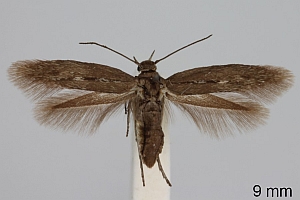

 +15Kontinente:EU
+15Kontinente:EU2. Diagnose
2.1. Geschlecht nicht bestimmt
2.2. Erstbeschreibung
3. Biologie
3.1. Nahrung der Raupe
- [Asteraceae:] Hieracium pilosella (Mausohr-Habichtskraut)
- [Polygonaceae:] Rumex acetosella (Kleiner Sauerampfer)
- [Fabaceae:] Anthyllis vulneraria (Gewöhnlicher Wundklee)
- [Fabaceae:] Lotus corniculatus ? (Gewöhnlicher Hornklee ?)
- [Fabaceae:] Ononis spinosa ssp. maritima ? [= Ononis spinosa ssp. procurrens, Ononis repens, Ononis costae ?] (Kriechende Hauhechel ?)
- [Lamiaceae:] Thymus praecox ssp. polytrichus ? (Langhaariger Thymian ?)
- [Plantaginaceae:] Plantago spp. ? (Wegerich ?)
- [Caryophyllaceae:] Cerastium spp. ? (Hornkraut ?)
- [Plumbaginaceae:] Armeria maritima ? (Strand-Grasnelke)
- [Cistaceae:] Helianthemum spp. ? (Sonnenröschen)
- [Caprifoliaceae:] Scabiosa columbaria ? (Tauben-Skabiose ?)
Baran (2003) studierte die Art an zwei Stellen in Polen und lieferte eine vorbildliche Beschreibung der Präimaginalstadien. Zu den Gewohnheiten der Raupen schrieb er: "Caterpillars are leaf miners throughout their life. In the study areas, larvae mined Hieracium pilosella and Rumex acetosella. However, the former was the main food plant in the studied habitats, while the latter was only a facultative one because only a few caterpillars were found on Rumex acetosella. Larvae live solitarily in silken tubes covered with grains of sand (Fig. 12). Frequently, a few tubes with caterpillars were observed on a single plant. Tubes are attached to the underside of leaves and they attain about 1.5–2.5 cm in length. During its development, the larva makes an irregular, blotchlike, pale brownish mine (Fig. 13) which may occupy an entire leaf blade; during feeding, the larva can change leaves. In the field, mines are relatively easy to discover because of the discoloration of the leaves, and the fact that they are visible on the upper surfaces of leaves. Larval tubes are attached to leaves that are in contact with sandy ground in most cases so that they are not noticeable without raising a leaf. The best way to find larva of S. siccella is by searching for brown spots on the leaves of the food plants."
Wenn an den polnischen Fundorten das Mausohr-Habichtskraut sehr viel stärker genutzt wird als der Kleine Sauerampfer, dann ist zu vermuten, dass das auch an anderen Fundorten ähnlich sein könnte. Jedenfalls dürften diese beiden Pflanzen kaum einem Fundort des Falters fehlen, und sehr viel mehr Arten, die diese Funktion übernehmen könnten, gibt es nicht. Wenn es auf der [Artseite von ukmoths.org.uk] heißt: "The larva feeds on a number of low foodplants growing in sandy conditions, and forms a tube manufactured from sand grains and silk." ist das sicher viel zu pauschal. Basis für diese Formulierung war die Auflistung von Bengtsson (2002) in Vol. 4.1 von "The Moths and Butterflies of Great Britain and Ireland". Dort heißt es zum Ei: "Undescribed. Laid on a variety of foodplants, including wild thyme (Thymus polytrichus), common bird's-foot-trefoil (Lotus corniculatus), plantain (Plantago spp.), mouse-ear (Cerastium spp.), kidney vetch (Anthyllis vulneraria), thrift (Armeria maritima) or restharrow (Ononis repens). Continental authors mention also hawkweed (Hieracium spp.), rock-rose (Helianthemum spp.) and small scabious (Scabiosa columbaria). Plants growing on wind-blown sand (Sterling, 1998) or near ants' nests (Schütze, 1931) are preferred." Fast alle diese Pflanzenarten geistern seit Langem durch die Literatur und werden hier - schon allein weil damals noch viele Scythris-Arten noch gar nicht beschrieben waren - sicherheitshalber erst einmal alle mit Fragezeichen angeführt. Ein Teil der Pflanzen passt gut in das von Baran (2003) entwickelte Schema, ein anderer Teil aber gar nicht. Ins Schema mit auf dem Sandboden anliegenden Blättern passt z.B. der Wundklee, und so überrascht nicht, was Davis & Parsons (2013) vom einzigen aktuell aus England bekannten Vorkommen zu berichten haben: "Management at a small site, the only known location for the species in the country, has involved digging small scrapes in the autumn over the last few years to encourage the early successional stages (on sandy soils) required by this species. Monitoring was again undertaken in 2012, involving counts of larval tubes (and adults if seen). Forty-eight larval tubes were found, surprisingly the same 12 total as in 2011, with 27 found in the previously dug scrapes. The larval tubes were found associated with a range of plants, although the majority were found under Kidney Vetch Anthyllis vulneraria."
4. Weitere Informationen
4.1. Andere Kombinationen
- Oecophora siccella Zeller, 1839 [Originalkombination]
(Autor: Erwin Rennwald)
4.2. Literatur
- Baran, T. (2003): Life history and description of the preimaginal stages of Scythris siccella (Zeller, 1839) (Lepidoptera: Scythrididae). — Entomologica Fennica 14 (4): 211-219. [PDF auf entomologicafennica.org]
- Bengtsson, B.Å. (2002): Scythrididae. - S. 278-294. In: Heath, J. & A. M. Emmet [ed.] (2002): The Moths and Butterflies of Great Britain and Ireland. Volume 4/1. Oecophoridae to Scythrididae (excl. Gelechiidae). – 326 S.; Colchester (Harley Books).
- Davis, A.M. & M.S. Parsons [eds.] (2013): Lepidoptera Conservation Bulletin Number 13: April 2012 – March 2013, Butterfly Conservation, Wareham. (Butterfly Conservation Report No. S13-18). [PDF auf butterfly-conservation.org]
- Erstbeschreibung: Zeller, P. C. (1839): Versuch einer naturgemäßen Eintheilung der Schaben. — Isis von Oken 1839 (3): 167-220. Leipzig (Brockhaus).




















